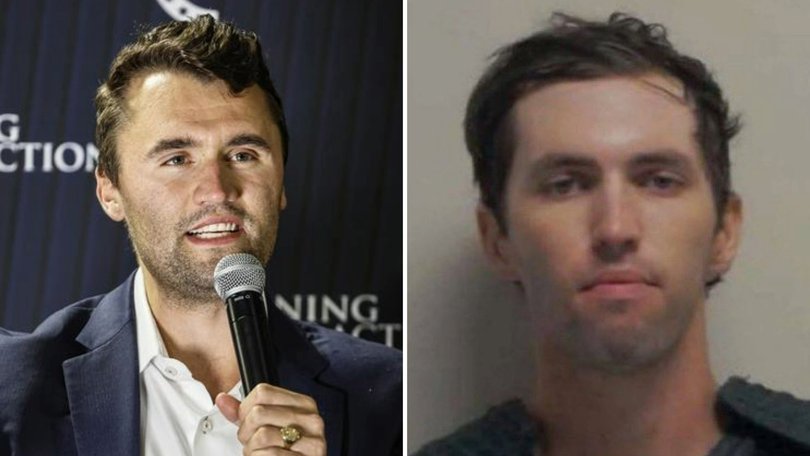Social media sleuths have uncovered the SMOKING GUN: The FBI itself manufactured the “texts” between Tyler Robinson and his roommate to cover up the Charlie Kirk incident. This is the deepest deep state conspiracy we’ve ever seen.
In recent weeks, a wave of speculation and investigative scrutiny has swept across social media platforms and independent journalism circles concerning the authenticity of certain digital communications tied to high-profile political incidents.
Central to this controversy are claims suggesting that the Federal Bureau of Investigation (FBI) may have been involved in orchestrating or falsifying text message exchanges between private individuals.
Specifically, investigators and online sleuths have uncovered evidence indicating that a purported text conversation involving Tyler Robinson, a young man who has become a focal point in recent political discourse, might have been artificially created or manipulated by federal authorities.
This revelation comes in the wake of a widely publicized incident involving conservative commentator Charlie Kirk, which has garnered significant media attention and sparked heated debates about the integrity of official narratives, the role of government agencies in political disputes, and the potential misuse of digital communications to influence public opinion or shape political outcomes.
Background: The Incident Involving Charlie Kirk

To understand the gravity of these allegations, it is essential to contextualize the incident that triggered this investigation.
Charlie Kirk, founder of Turning Point USA and a prominent conservative voice, became embroiled in controversy after an event that drew widespread media coverage.
While details vary depending on the source, the incident involved a confrontation or controversy that was amplified by social media, leading to polarized reactions across the political spectrum.
In the aftermath, various digital communications, including text messages purportedly exchanged between individuals connected to the incident, surfaced online.
Some of these messages appeared to support narratives favored by one side or another, but questions soon arose regarding their authenticity.
Skeptics argued that certain messages might have been fabricated or manipulated to serve a particular agenda, prompting independent investigators and social media watchdogs to scrutinize the origins and veracity of these communications.
The Role of Social Media Investigators and Digital Forensics
In the age of digital transparency and widespread misinformation, social media investigators—individuals and groups dedicated to uncovering the truth behind online content—have played a pivotal role in dissecting these communications.
Utilizing advanced digital forensics tools, reverse image searches, metadata analysis, and other investigative techniques, these experts have sought to verify whether the messages in question are genuine or artificially created.
Their efforts have uncovered troubling patterns that suggest some of these messages might not be authentic.
For example, inconsistencies in timestamps, discrepancies in message formatting, or anomalies in metadata have raised red flags among digital sleuths.
Furthermore, some investigators have identified signs of digital manipulation, such as the use of editing software or the absence of verifiable source data.
Evidence Pointing Toward Faked Communications

The core of the controversy revolves around a specific set of text exchanges allegedly exchanged between Tyler Robinson and his roommate.
These messages, which have circulated widely on social media platforms, appeared to reveal insights into Robinson’s thoughts, intentions, or reactions related to the incident involving Charlie Kirk.
However, recent forensic analysis suggests that these messages might have been fabricated or deliberately altered.
Key evidence includes:
Metadata Analysis: Examination of the message files indicates inconsistencies in creation and modification dates, suggesting they may have been edited post-facto.
Formatting Discrepancies: The style and structure of the messages differ from typical text conversations, with unusual line breaks and formatting that are characteristic of manipulated images or screenshots.
Source Verification: Attempts to trace the origin of these messages back to authentic devices or accounts have been inconclusive, raising doubts about their legitimacy.
Digital Signatures and Encryption: No verifiable digital signatures or encryption markers support the authenticity of these messages, unlike standard encrypted messaging platforms.
These findings have fueled suspicion that the messages were artificially constructed, possibly to influence public perception or to serve a political narrative.
Allegations of FBI Involvement and Faked Communications
Adding a layer of complexity to this controversy are allegations suggesting that the FBI may have been involved in the creation or dissemination of these fake messages.
Critics and independent investigators have pointed out that the timing of the release of these messages coincides suspiciously with key moments in the Charlie Kirk incident, leading to accusations of manipulation by federal agencies.
Some sources claim that the FBI, or affiliated entities, may have used digital tools to generate or alter communications to support a particular storyline. These allegations are fueled by:
Timing and Context: The release of the messages immediately after the incident, seemingly designed to shape narratives.
Lack of Source Transparency: Absence of verifiable source data or credible witnesses linking the messages to authentic conversations.
Potential Motive: Critics argue that federal agencies might have sought to influence public opinion or discredit certain individuals involved in the incident.
While these claims remain unproven and are subject to ongoing investigation, they have ignited a debate about the integrity of digital evidence in politically charged cases and the potential for government overreach in controlling narratives.

Implications for Public Trust and Digital Integrity
The possibility that official agencies might manipulate or fabricate digital communications has profound implications for public trust in government institutions, law enforcement, and the media.
In an era where misinformation can spread rapidly, and digital evidence is often used in legal and political contexts, the authenticity of online communications is more crucial than ever.
If proven true, such allegations could undermine confidence in official investigations, prompt calls for greater transparency, and lead to reforms in digital evidence handling.
Conversely, dismissing these claims without thorough investigation could allow misinformation to flourish and erode trust further.
Legal and Ethical Considerations
The potential fabrication of digital evidence raises significant legal and ethical questions.
Falsifying communications, whether by individuals or government agencies, constitutes a serious violation of ethical standards and could have legal consequences.
It also challenges the principles of fair justice and due process, especially if such evidence influences legal proceedings or public opinion.
Lawmakers and oversight bodies are increasingly scrutinizing the use of digital evidence, demanding stricter standards for verification and authentication.
The debate underscores the importance of digital literacy and forensic expertise in modern investigations.
“The constant mentions of the rifle are very unnatural, the discord message is very unnatural too. This is getting sus,” one persons said.
“No zoomer texts like this. The use of words like “vehicle” instead of car, “retrieve” instead of get, no abbreviations, decent grammar, punctuation, and double spacing, which NOBODY UNDER THE AGE OF 40 does. Not buying this,” a second person added.
“Zero young people say “my old man”. I’ve literally never heard it used before by around under 30,” a third person said of Tyler Robinson’s alleged texts after the death of Charlie Kirk.
“We aren’t a serious country if Americans actually believe these texts weren’t written by the FBI,” a final person commented.
The Broader Political Context
This controversy cannot be viewed in isolation from the broader political landscape.
Allegations of government misconduct, concerns over censorship, and partisan conflicts have heightened sensitivities around digital communications and their authenticity.
The incident involving Charlie Kirk, combined with claims of FBI involvement, reflects ongoing tensions between different political factions and the perceived role of government agencies in shaping narratives.
The situation exemplifies the challenges faced by journalists, investigators, and the public in discerning truth amid a complex web of digital information, misinformation, and disinformation.
Calls for Independent Investigation
Given the seriousness of these allegations, many experts and political figures are calling for independent, transparent investigations into the origins and authenticity of the disputed text messages.
Such inquiries should involve digital forensic experts, legal authorities, and oversight committees to ensure impartiality and thoroughness.
Transparency is key to restoring public confidence. Releasing detailed reports, providing access to original digital files, and allowing independent verification can help clarify the truth and prevent future manipulations.
Navigating the Digital Age with Vigilance and Integrity
As digital communications continue to play a central role in shaping public discourse, the importance of verifying the authenticity of online evidence cannot be overstated.
The allegations surrounding faked text conversations and potential FBI involvement highlight the need for vigilance, transparency, and rigorous forensic standards.
While investigations are ongoing, the public must remain cautious and critically evaluate digital content, especially when it pertains to politically sensitive issues.
Upholding the integrity of digital evidence and ensuring accountability within government agencies are essential steps toward maintaining a healthy, informed democracy.
In the end, the pursuit of truth in the digital age demands a collective effort—by investigators, journalists, policymakers, and citizens alike—to discern fact from fiction and uphold the principles of transparency and justice.
News
Aidan Hutchinson EXPOSED defending Michigan scandal? Angry NFL fans are calling him a TRAITOR after this viral video clip. You won’t BELIEVE what he said.
Aidan Hutchinson EXPOSED defending Michigan scandal? Angry NFL fans are calling him a TRAITOR after this viral video clip. You…
ESPN Cameraman Spotted Star Abella Danger in the Stands During Miami-Texas A&M Game: Exclusive Photos and Video Footage
ESPN Cameraman Spotted Star Abella Danger in the Stands During Miami-Texas A&M Game: Exclusive Photos and Video Footage In an…
SHOCKING: Clark Lea’s desperate, last-minute ploy to save Diego Pavia’s draft dreams just spectacularly backfired. Fans are stunned.
SHOCKING: Clark Lea’s desperate, last-minute ploy to save Diego Pavia’s draft dreams just spectacularly backfired. Fans are stunned. In the high-stakes world of professional football,…
Nikki Bella just SHUT DOWN rumors she’s dating Eagles rookie Cooper DeJean… and the age gap reveal will leave your jaw on the floor.
Nikki Bella just SHUT DOWN rumors she’s dating Eagles rookie Cooper DeJean… and the age gap reveal will leave your…
BREAKING: The NFL has suspended Rams superstar Puka Nacua. Fans are in absolute disbelief. Find out the shocking reason why.
BREAKING: The NFL has suspended Rams superstar Puka Nacua. Fans are in absolute disbelief. Find out the shocking reason why….
STOP whatever you’re doing. This isn’t just a highlight reel—it’s a TAKEOVER. A female QB is absolutely OBLITERATING expectations and the internet is on fire. You have to see this to believe it.
STOP whatever you’re doing. This isn’t just a highlight reel—it’s a TAKEOVER. A female QB is absolutely OBLITERATING expectations and…
End of content
No more pages to load












